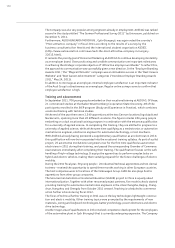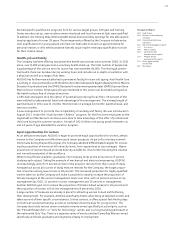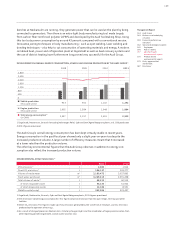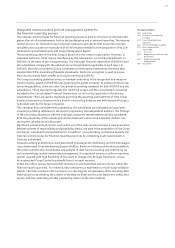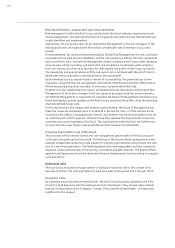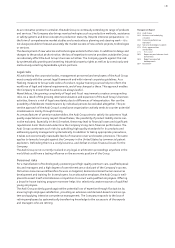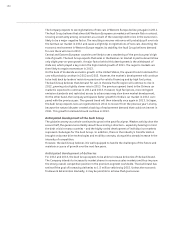Audi 2011 Annual Report Download - page 177
Download and view the complete annual report
Please find page 177 of the 2011 Audi annual report below. You can navigate through the pages in the report by either clicking on the pages listed below, or by using the keyword search tool below to find specific information within the annual report.
174
Electromechanical steering
The electromechanical steering underwent technological refinement as part of the A4 car line
product improvement.
The steering gear incorporates an electric motor that generates the servo power to assist the
driver with steering. With this advanced electromechanical steering system, the electric motor
now no longer needs to provide steering assistance when the car is traveling in a straight line,
thus cutting energy consumption. Thanks to the electromechanical steering, fuel consumption is
reduced on average by up to 0.3 liters per 100 kilometers depending on engine version, cutting
CO₂ emissions by up to 7 g/km.
The advanced electromechanical steering can also boost driving safety – for instance by regulating
power assistance intelligently if there is a risk of skidding. The electromechanical steering also
promotes driving safety in combination with the optional lane departure warning system Audi
active lane assist, which actively helps the driver to stay in lane by providing gentle steering
impulses.
Audi ultra
Vehicle weights have been steadily rising in recent years, above all due to higher comfort and
convenience expectations and tougher safety requirements. Because fuel consumption falls by
about 0.3 liters per 100 kilometers for every 100 kilogram reduction in a vehicle’s overall weight,
reversing this upward spiral is a vital aspect of improving efficiency.
Lightweight construction has acquired new importance along with the emergence of electric
mobility, because savings need to be made elsewhere to compensate for the battery’s high
weight. A lower power-to-weight ratio also means greater agility.
The Audi brand has therefore grouped all lightweight technologies and activities under the
umbrella brand Audi ultra within the framework of its Strategy 2020. At the same time, the
Company has the declared target to make every new Audi model lighter than its predecessor.
The Audi brand boasts a long and successful track record in lightweight construction. Most
notably its Audi Space Frame (ASF) technology proved a trailblazing development when it was
launched on the Audi A8 in 1994, the world’s first volume-built vehicle with unitary aluminum
body. The Company has since produced around 700,000 vehicles using the ASF principle –
whether made entirely from aluminum or aluminum hybrid designs – as hard evidence of its
expertise in handling lightweight construction on a large scale.
Today, the Audi brand places emphasis on using an intelligent mix of materials to achieve maxi-
mum performance at every point in the car through use of the optimum material. As well as
aluminum and high-strength steels, the Company is increasingly turning to carbon fiber-reinforced
polymers (CFRP) and magnesium. Thanks to extensive lightweight construction measures, the
brand with the four rings succeeded in reducing the weight of its new Audi A6 full-size sedan by
as much as 80 kilograms compared with its predecessor, despite its even better safety features
and improved comfort and convenience.
The Audi brand also consistently applies lightweight construction principles in the R8 GT Coupé
and R8 GT Spyder, both launched in 2011. For instance, the curb weight of the R8 GT Coupé was
cut by 100 kilograms compared with the R8 Coupé, to 1,525 kilograms.


